
Once again, I find myself trying to work out whether or not I’ve “had a go” at an Olympic discipline to a sufficient degree to tick it off the list. Last weekend’s antics have certainly left a mark – several marks in fact – I have bruises all over my knees and thighs from trying to get out of a capsized slalom kayak.
After much thought, I have decided that, far from getting “all eleven canoeing events knocked off in a weekend” as I had originally (and quite ridiculously) thought I might, I have actually completed just one of them to a sufficient standard to tick it off the list without feeling dishonest.
Said event is the K-1 slalom. Under the watchful eye of a man who twice competed at the discipline in the Olympics and now coaches the Great Britain Olympic team, I paddled to the best of my ability on a white water slalom course. The fact that ‘the best of my ability’ involved me nearly drowning twice and managing to go through the grand total of one slalom gate at the very bottom (and least violent part) of the course is neither here nor there.
After much e-mail discussion with Tim, a consensus was reached that any further attempts on the white water would not only be fruitless, but also just downright dangerous. It has been suggested that perhaps a trip down the white water on a raft might be a good idea, to give me a feel for just how terrifying it must be in a canoe. I like the idea of that – from what I can gather, you don’t get quite so firmly wedged into a raft that you risk losing a leg trying to get out of it when things go pear-shaped.
Shaun Cavern, he of the flatwater expertise, suggested I come back to Nottingham another time and have a go in “something a bit more stable” than a fully-fledged K-1 sprint boat. I look forward to taking him up on that offer some time before the summer of 2008. I’d like to at least record a time for the 500 and 1000 metres in order to put the pro’s abilities into some sort of context.
One little factoid that Shaun threw out there that gives an idea of the speeds involved: the top guys can move a K-4 boat sufficiently fast that a young child could water-ski behind it. I suggested we might have more luck if I strapped on a pair of water-skis and let them try it with me – it’s not that I am claiming any talent in that direction, I’m just comforted by the fact that ‘soaked to the skin’ is the state you’re expected to be in by the end of that pursuit.
I’d also like to have a go in a Canadian canoe on the flat. I don’t think they have a beginner’s version of that, so my only chance to complete 500 metres in one would probably be to sink it somewhere deep. If I did it after the K-4 water-ski, at least I’d already be wet.
But for now, in terms of the canoeing events, it’s one down, ten to go – and overall? Nine down, one hundred and nineteen to go. It would be fair to say that I’m a little behind schedule.
The next big event in the diary is the 50 km walk. If you want to take part, drop me a mail and I’ll send you a sponsorship form.
In the meantime, if you have been inspired to give canoeing a go – it’s really not as hard as I made it look I’m sure, and, even if it is, it’s still lots of fun - here are some links that will help you on your way:
British Canoe Union
(Including their guide to getting started)
The National Water Sports Centre
Paddling.net
JoJaffa goes Canoeing!
Reviewing Canoeing
Posted by John McClure at 7:19 pm 1 comments
Splash II
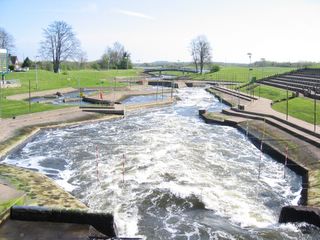
The course was 'turned right down' due to 'an incident' the day before.
After Saturday’s soaking, I woke with a fluttering in my stomach on Sunday – I would put it down to the River Trent and all the wondrous things I might have swallowed the day before, but I would be lying to myself and to you. I was just nervous.
After we left Shaun Cavern on Saturday, Tim and I took a wander up to the white water slalom course. I imagine that it looks fairly intimidating at the best of times, but it was made all the more so by having half a dozen children zipping about on the water like they’d been born in a kayak. Not only was I likely to fail miserably on Sunday - I was likely to fail miserably where so many nine year-olds had succeeded before me.
Ian Raspin, coach to the Great Britain Olympic team, met us at the course bright and early on Sunday morning. He’s a stocky little man with a friendly manner and a ready smile that puts you instantly at ease, even if you can see that, behind that, there clearly lies a character who would walk through brick walls to get to whatever he wanted.
He explained that there had been 'an incident' on the white water the day before and that unfortunately it was closed. I tried very hard to look disappointed rather than relieved. He suggested we get kitted up and have a paddle about on the practice lakes in the meantime, and then maybe we could sneak on at the bottom of the course later on. It wasn’t the complete abandonment I was secretly hoping for, but it was a start.
As he helped me shove my knees into the kayak, Ian explained that you don’t get many slalom racers over six-foot tall. I didn’t mind the cramped conditions at all – I felt a lot safer than I had the day before (one's knees stick out of a racing boat).
This was ironic – a couple of hours later, it would be my excessively long legs that would be preventing me from sliding out of my capsized kayak quite as elegantly and safely as Ian made it sound like I’d be able to.
While the sprint boat is designed to go as fast as possible in a straight line, the slalom boat is designed to be as manoeuvrable as possible and to provide a bit more buoyancy than I had previously enjoyed. This was a good thing and a bad thing – I wasn’t quite as fearful of tipping the boat over as I had been the day before, but I was showing a nasty tendency to go round and round in circles.
After half an hour on one practice lake, we paddled through to another one that had some slalom gates strung out across it. Ian zipped between them with the consummate ease you would expect from a double Olympian, adjusting them with one hand while he paddled with the other. He pulled four gates into a straight line and suggested I might like to try and paddle through them.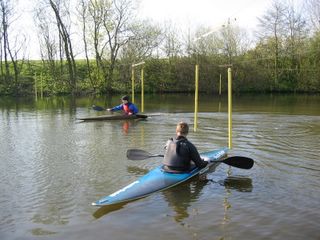
On the practice lake with Ian Raspin, a real Olympian!
I resisted the temptation to scoff at the level of simplicity. I also resisted (briefly) the temptation to swear as I missed the first gate completely despite having started my run less than twenty feet from it. Sadly, the lake had no current running through it that I could blame.
After an hour in the gated lake, I was just about able to get through four gates in a straight line, albeit with a very dainty little pirouette in the middle of my run. Ian seized the moment:
“Because of what happened yesterday, they’ve turned the speed of the white water right down today, so I think you might be ready to hit the bottom of the course and see if we can get you to go through a gate on the moving water, what do you think?”
“Absolutely. That would be great!” I lied. “What did happen yesterday?”
“It’s very sad. Someone died I’m afraid.”
“My god!”
“I know - it’s terrible. Anyway, I’ll nip back and get you a helmet and so on and then we can wander down.”
And with that he turned around and paddled back to the centre, leaving me to think about the fact that someone had died on the course the day before. Now, it turns out that the poor soul who passed away on Saturday might have died regardless of where he was at the time, but on Sunday, as I stood looking at the white water and waited for Ian to come back, the connection between dying and canoeing seemed fairly strong and not a little daunting.
When we finally made it to the water’s edge and I started folding myself into my boat again, I was reminded of Ian’s comment on the phone the first time we had spoken: “If you’ve never been in a kayak before, there’s about as much chance of you getting down the white water course at all, even without gates, as there is of the sky falling in.”
I don’t think that is quite right – I think I could live in a kayak for the next twenty years and still not make it down alive. As I shoved off from the side of the course I couldn’t help but wonder how much more terrified I might have been if the water hadn’t been ‘turned right down’.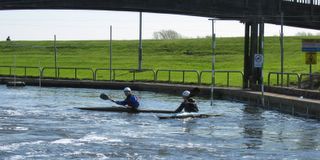
As long as I let the water move me and didn’t try to paddle against it, I felt reasonably secure, but as Ian tried to teach me the basic technique of paddling across the current from one eddy to another I felt any semblance of confidence I’d built up begin to ebb away.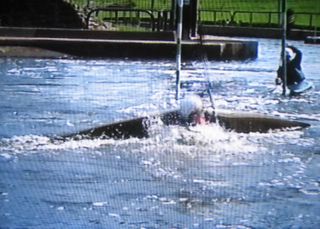
"I wonder what the bottom of this one looks like..."
Sure enough, on my first full-blooded attempt to cross the course, I capsized. Far from the instantly amusing spectacle this had created the day before, I found myself unable to get out of the boat.
Ian had talked me through how to do it at great length, but strangely, with my head touching the bottom and the boat clinging to my legs as the water gushed all around me, I completely forgot everything useful he had told me and started trying to do some as yet undiscovered version of the breaststroke like some demented tortoise with a canoe for a shell.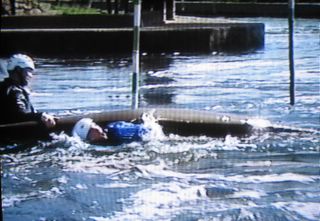
Ian to the rescue as I gasp for air like a drowning tortoise.
Ian was laughing as he fished me out, but I was sure I’d been mere moments from drowning. I’ve since watched the video. I was probably under the water for about four and half seconds – five at the very outside.
"Not now, Kato! Can't you see I'm drowning?"
I went snowboarding once. I was handy enough at it and loved it for the first ten minutes. Then I crashed, and that was the end of that. From that moment on, I was a nervous wreck and couldn’t commit to any movement I made for fear of falling. As a consequence, I fell over a lot.
This same scenario was now in full flow on the slalom course. Having drained the boat, I got back in and paddled out into the current again. When I let it take me where it wanted to I was fine, but the instant I tried to move in any direction the water didn’t want me to go, I was all over the place. I lasted another ten minutes before I once again found myself underwater.
This time I tried to stay calm. I reached down and pulled the cover off my legs and set about trying to pull my legs out of the boat. But I was upside down, and my face hit the bottom, and the water was thundering in my ears, and I couldn’t breathe. I abandoned my calm approach and resorted to the demented tortoise impression. Fortunately, Ian was there again to pull me out.
It had a curious taste - not unlike a pair of three-day-old damp socks on a radiator.
They say ‘once bitten; twice shy’ – I’m not sure what the saying is for when you’ve been bitten twice, but I suspect it might end with the word ‘petrified’. If it doesn’t, it should. Ian sensed my increasing fear and suggested that maybe I should try and get it through one gate for the camera and we could call it a day.
I just about managed it, but only because Ian had the decency to pull the thing into the middle of the course – directly over the line anything buoyant would have taken if you’d chucked it into the river.
We climbed out of our boats and headed back up the hill to shower and drink Coke (the fact that the latter helps kill any nastiness you might have swallowed in the river is both pleasing and slightly worrying at the same time).
I will write more about this sport in the days to come, but for now I can only end with thanks – to Ian for answering Tim’s e-mail in the first place and for giving up his Sunday to help – to Shaun for doing likewise with his Saturday – and to both of them for offering to help again in the future if they can. If I can meet generosity like theirs in every sport I have to complete, this challenge will be a doddle!
Ian Raspin - what a thoroughly bloody nice chap.
Posted by John McClure at 10:34 pm 6 comments
Making a Splash
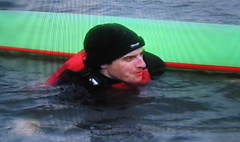
Can I canoe? Can I bobbins.
It’s possible that this sport may define the phrase the TV commentators love to bandy about - “It’s not as easy as these athletes make it look.”
That said, it might not be quite as difficult as I was making it look.
Saturday morning was all about the flatwater. Shaun Cavern, expert canoeing coach, met Tim (expert cameraman) and me (distinctly inexpert canoeing wannabe) at the finish line of the 2000 metre lake.
I’d been warned that the length of the lake would surprise me, but it still surprised me. As our host put it: “Sitting at the far end pointed this way, it feels like you can see the curve of the earth.”
When we arrived, Shaun was talking to some lunatic who had clearly forgotten his kayak and had come out for a paddle around in a hollowed out pencil. As we approached, the lunatic paddled off at a remarkable speed for a man kneeling on one knee in half an HB.
Introductions completed, I asked Shaun what the lunatic was playing at. “That was a C1 – I imagine you’ll have to do that one too at some point, won’t you? Probably not today though.” Probably not, no.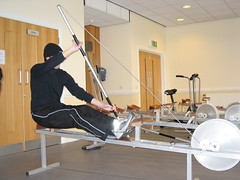
It's a bit like trying to swing two golf clubs at the same time.
It all started promisingly. Shaun took us inside to a very ingenious canoeing machine to run me through some basic techniques. I paid very close attention and tried as hard as I could to do what he was telling me – cock the wrist this way, point the elbow that way, reach to the front of the stroke with a straight arm. It seems funny now – by the time I got into the boat, it became fairly clear that I wasn’t going to be reaching for much other than a towel and a change of clothes before too long.
A ‘sprint’ kayak is designed to do just that - sprint - to go as fast as possible in a straight line. Unlike the kayak I paddled around Plettenberg Bay a month ago, which remained pretty stable despite a fifteen-foot Indian Ocean swell, the kayak Shaun put me in felt like it was going to struggle with the fifteen millimetre ripple being thrown up by the cold Nottingham wind.
Having suggested I might be better to take my shoes off in case they got wet, Shaun took great care in telling me how to get into the boat. I followed his instructions to the letter and got in without a problem. Once there, I listened just as carefully to him telling me how to get out again, but I knew I wouldn’t need that information. My only question about the whole process maybe gave away just how confident I was feeling, “Is the water deep?” His answer wasn’t quite what I was looking for… “It’s deep enough.”
Deep enough for what? To drown? To avoid hitting my head on the bottom if I went belly up? To contain flesh-eating animals?
I set off bearing the grimace of a man in trouble. The slightest shift in weight makes the boat wobble. “Just let it wobble. Never let go of your paddle,” Shaun shouted from the bank (not that I’d progressed far enough out for him to need to shout) “Don’t fight it or you’ll get wet.”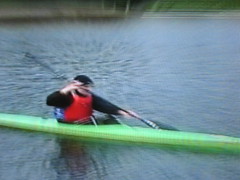
Cock the wrist this way, point the elbow that way, reach to the front of the stroke with a straight arm.
I was already getting wet. The shape of the racing blade may be scientifically precise in terms of gaining that vital extra second, but it is also quite conducive to scooping water all over your lap when you’re paddling at 0.62 mph.
Somehow I made it 40 metres to another jetty where I was met by the increasingly amused Shaun and the constantly amusing Tim. “That wasn’t too bad – you made it further than I thought you would.” Shaun confided gently, encouraging me. “1000 metres is going to take you about a week at that speed, mate.” Tim quipped from behind the camera.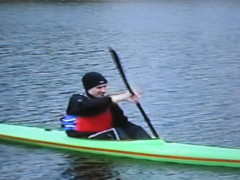
I turned the boat around and headed back in the direction from which I had come. I was starting to get the hang of it a little. It felt like it was wobbling less. Tim later likened it to trying to ride a bicycle very slowly – it’s actually easier to keep it balanced if you’re going a bit faster. Perhaps I was thinking the same thing when I decided to dig my next stroke in a bit deeper and build up some speed.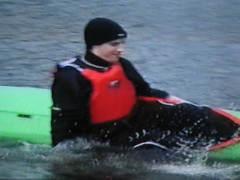
You don't get great whites in Nottingham, do you?
I cocked my wrist this way, I pointed my elbow that way, I reached to the front of the stroke with a straight arm, and then I fell in. The boat wobbled and I fought it (mistake number one), and then I let go of the paddle (mistake number two) in order to cling to the side of the boat (mistake number three), and that was all she wrote. I’d call it a capsize, but it wasn’t even worthy of the name. It was like a rat deserting a sinking ship.
Like a lady swimming with a new perm - my hat stayed almost dry.
Shaun was right - it was indeed "deep enough"
The water was incredibly cold and by the time I’d swum the twenty metres back to the jetty I couldn’t feel my fingers or toes anymore. Shaun looked me up and down and asked me if I wanted to have another go or to go and have a shower. It was all I could do to stop my teeth chattering long enough to take the second option.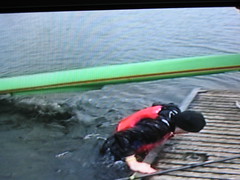
All ashore that's going ashore!
Tim reassured me the whole way to the changing rooms that really it was a great success – he’d got the whole thing on film and my shoes were still dry. All I could think was that the next day I was going to have to do it again, only then I was going to have to do it through a raging torrent rather than on a millpond.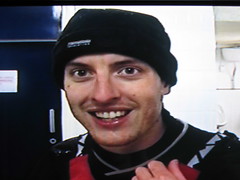
Despite the cold and the humiliation, I still found it quite amusing.
* * *
I'll save the write up of Sunday's exploits for tomorrow night - I'm still exhausted from the weekend, so if I'm going to get back to my triathlon training in the morning, I'm going to need to go to bed about half an hour ago.
Posted by John McClure at 9:38 pm 2 comments
Canoeing Update
Coming back down the M1 on the way home this afternoon, I saw sign after sign telling me that 'tiredness kills'. In light of that terrifying fact, I'm going to keep this brief and head to bed before I expire.
Canoeing is hard - I'll tell you how hard in the next few days when I regain enough strength to type a proper post and stop tasting the nastier elements of the River Trent every time I swallow.
In the meantime, check out the cause's latest bit of publicity (thanks Phil!).
Posted by John McClure at 9:22 pm 1 comments
Can You Canoe?

Action Man - anatomically incorrect in almost every respect, with the possible exception of his facial expression whilst at the helm of a kayak.
The first thing you should know is that kayaking and canoeing are essentially the same thing – that is to say, all kayaking is canoeing – but not all canoeing is kayaking. The second thing you should know is that this isn’t as hard to grasp as I’m making it sound.
There are two types of canoeing race – flatwater (or sprint) and slalom. In an Olympic games, the sprints take place on the same stretch of water that the rowers use (although not at the same time), while the slalom is run through 25 gates on a specially constructed white water course.
There are also two types of canoe – the Canadian and the kayak. The Canadian is paddled from a kneeling position with a single-bladed paddle. The kayak is paddled from a seated position with a double-bladed paddle.
See? Simple.
Well… simple to understand anyway – simple to watch on TV even. However, I’m reliably informed that ‘simple’ isn’t a word I’ll be using much to describe the actual experience of having a go. This weekend I’m heading to Nottingham to the National Watersports Centre to be put through my canoeing paces by a former Olympian, who is now a coach with the Great Britain team. His first question was “Can you swim?” and his answer when I asked him what I should wear was more or less “Something you don’t mind getting wet.”
The BBC website has an interesting brief history of canoeing if you’re keen to know more about where this sport came from. The essential Olympic facts are:
Flatwater racing became a display sport in the games of 1924, and was included as a full Olympic sport for the first time in Berlin in 1936 for men and London in 1948 for women.
Slalom made its debut in Munich in 1972, but did not appear again until Barcelona in 1992 (where my mentor for this weekend finished 17th – he then finished 9th in Atlanta four years later).
It should be an interesting weekend – BBC Nottingham have threatened to send a radio crew down to laugh at my efforts, and I’m hoping to convince the Nottingham Evening Post that there may be an opportunity to get some exclusive shots of a drowning canoe novice. I shall, of course, report back on Monday.
In the meantime, to keep you amused, check out Statue John’s brilliant Internet find – it’s a tailor made training video for the freestyle urban athlete!
Posted by John McClure at 8:15 pm 6 comments
Ultimate Gym Membership

The pool is heated to 27 degrees - slightly lower than a normal leisure pool. Hopefully, it will contain less toddler wee too.
After many threats (all of which turned out to be largely hollow) I have finally joined a gym. The good people at the Oxford University Sports Centre are the lucky blighters who will have the pleasure of my huffing, puffing, heavily sweating presence in the coming months as I train for the various events I need to complete.
The facilities are ideal for my needs – in addition to the standard things you’d expect to find at a gym (pool, power-lifting room, running, cycling, rowing machines, tennis courts, squash courts) they also have an athletics track - or, as I like to think of it, the athletics track.
Almost 51 years ago, on a cold and breezy May evening, Sir Roger Bannister (just plain Roger in those days) hurled himself round the Iffley Road track four times (a mile) in less than four minutes, thereby becoming the first human being ever to do so – or, the first human being to do so in the presence of a stopwatch-wielding Norris McWhirter at any rate.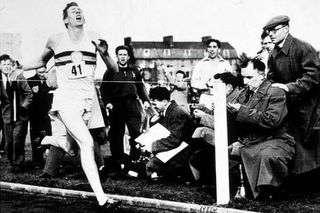
Bannister has an enormous nose and skinny legs - maybe I've found my milieu.
I haven’t yet ventured out onto the track to run, but when I do for the first time I will be running four laps to see what all the fuss is about.
Posted by John McClure at 6:11 pm 1 comments